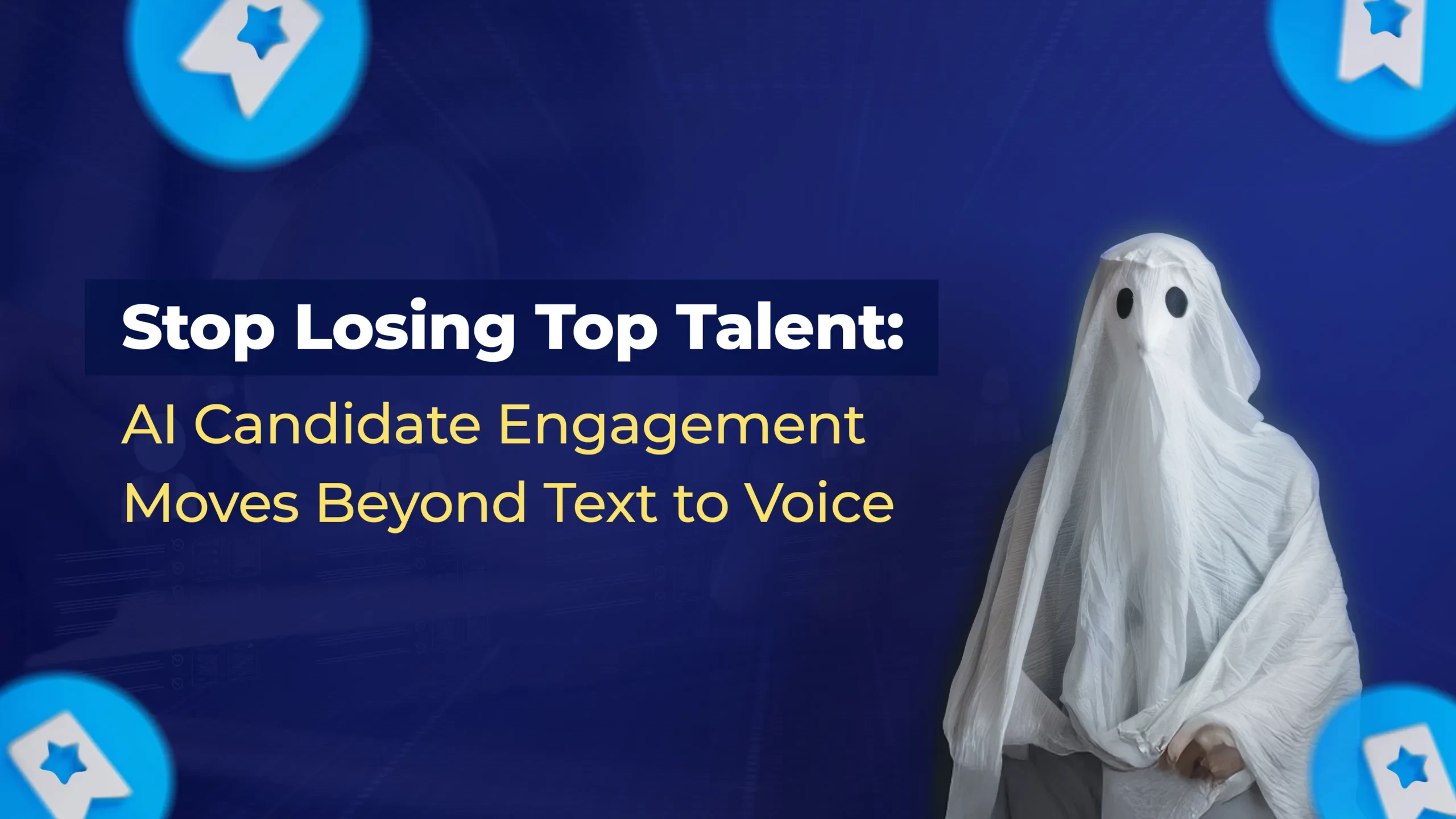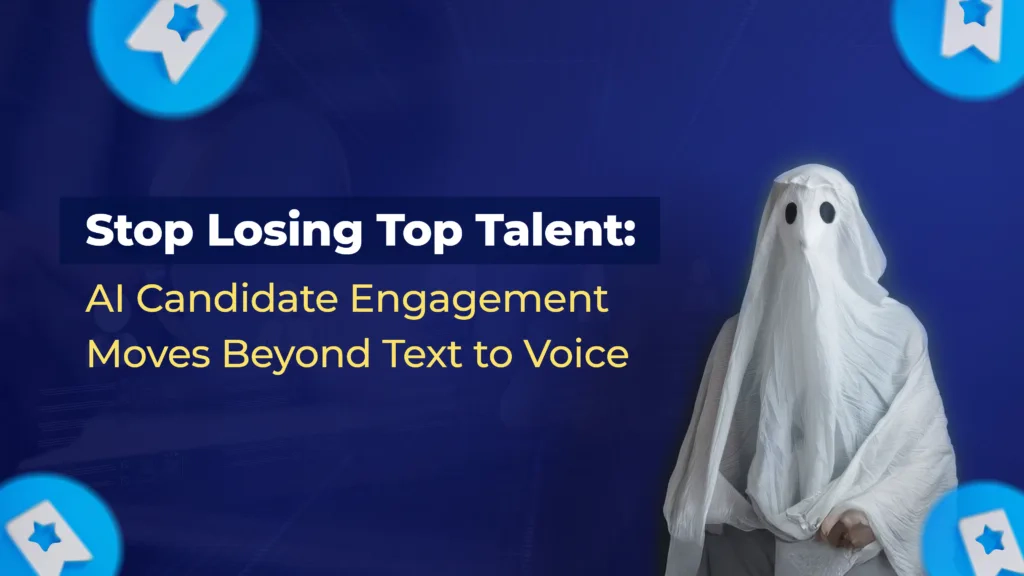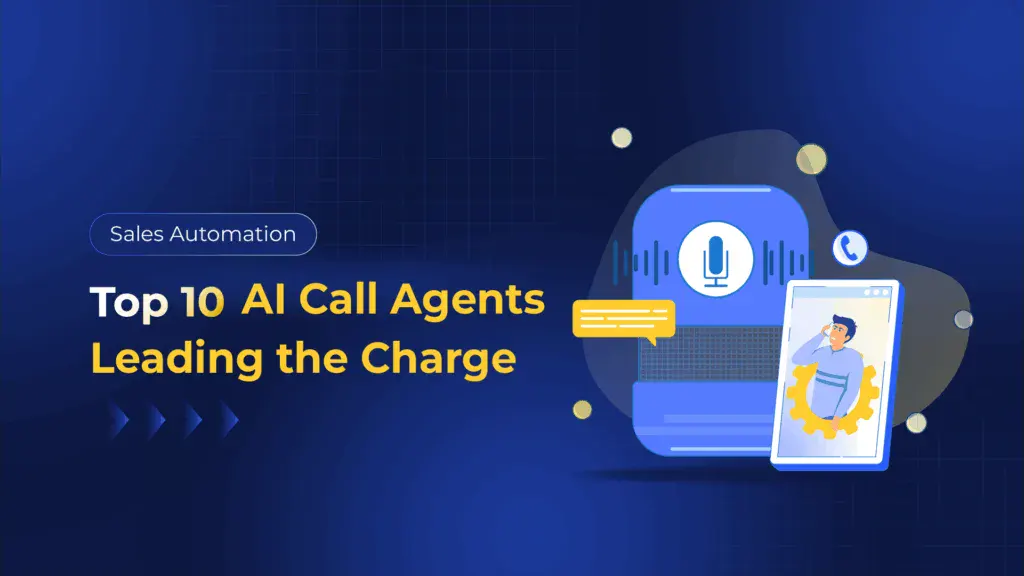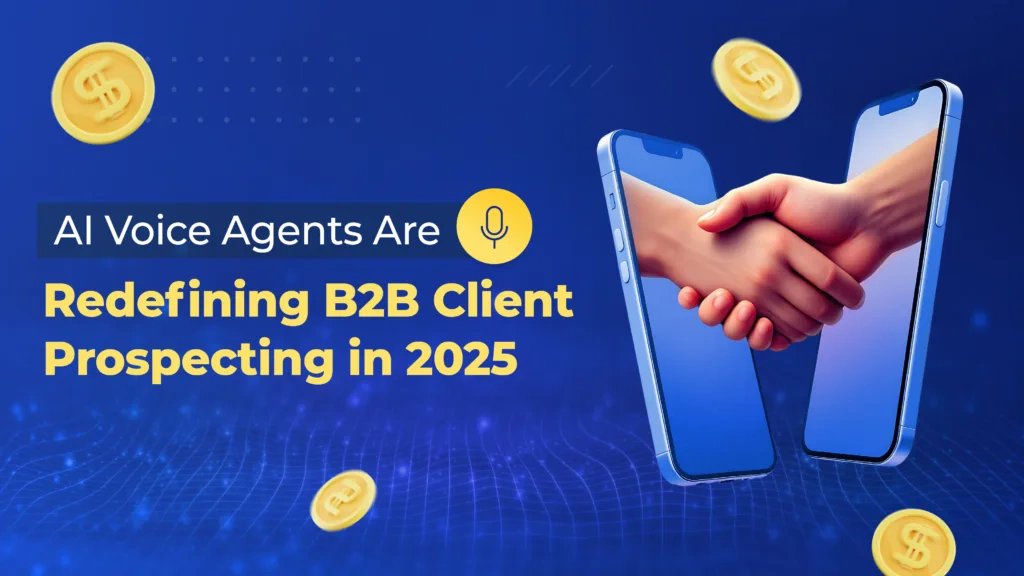Recruiters have relied on text for years to connect with job seekers, but today’s top candidates expect more.
An AI candidate engagement platform isn’t just another tool; it’s the bridge between fast AI hiring solutions cycles and meaningful candidate experiences.
AI voice recruitment software is redefining how teams engage, moving from traditional, text-based outreach to personalized, voice-driven conversations that yield results.
Let’s walk through why AI recruiting engagement is making this shift, how voice recruitment software rewrites the rules, and what you must do now to stay in the game.
Conversational AI in Recruitment Wins Over Text (When Done Right)
The candidate side: voice feels real.
Candidates increasingly expect engagement that sounds human. Voice bypasses skim filters, captures tone and inflection, and makes conversations feel alive. What reads like a robotic script via SMS can land as empathy or warmth over voice.
Moreover, in US markets, 60% of adults under 30 already use AI to search for information. They’re comfortable talking with AI. (Source: AP News)
The recruiter side: scale + insight.
A quality AI candidate engagement platform amplifies your reach without multiplying headcount. Voice interactions (calls, voicemails, call backs) layered over your CRM or ATS let you scale and still capture nuance: pauses, hesitation, tone shifts. That’s good for prioritizing follow-up.
According to a recent voice-AI case study, one firm sourced 2,000 candidates in seven days, held 455 real voice conversations, and completed 10 placements, all in a timeframe that used to take four weeks. (Source: Apollo Technical)
What “Text-to-Voice Hiring Automation” Really Means
Let’s unpack the building blocks of this next-gen architecture:
Outbound Voice Outreach
The system dials, leaves dynamic voicemails, or connects candidates immediately, all based on trigger logic (e.g. “openers who submitted in the past 24 hours but haven’t replied”). This is the move from chat nudge to voice nudge.
Adaptive Voice Screening
Once connected, candidate responses trigger branching logic: qualification questions, clarifications, or redirect to human if complexity arises. You capture structured data and sentiment. (This is where voice recruitment software flexes.)
Seamless Integration and Log Sync
Every voice event, transcript, and sentiment flag flows into your ATS/CRM. That maintains context and lets human recruiters jump in with all candidate history visible, no black box.
Analytics & Feedback Loop
The system ranks which voice scripts perform best, flags drop-off spots, and surfaces patterns (e.g. “candidates in X geography hang up on script version B”). Use that to refine your content and flow.
Together, this is AI recruiting engagement that doesn’t only talk, it listens, learns, and adapts.
Voice AI Recruiting Real Impact: Stats You Can’t Ignore
- 87% of U.S. companies now use AI in recruiting, making this shift table stakes. (Source: Shortlistd)
- In recruitment operations, integrating AI for scheduling or screening can slash coordination time by 60–80%. (Source: Truffle)
- Over 70% of hiring managers believe AI helps assess a candidate’s true compatibility beyond resume match. (Source: Insight Global)
- Up to 30–50% of recruiter FAQ interactions can be deflected via automated Q&A or voice bots. (Source: Truffle)
- The global AI voice market hit $5.4B in 2024, growing 25% year-over-year. (Source: Forbes)
Those numbers show volume, but more importantly: velocity and conversion lift become your competitive advantage.
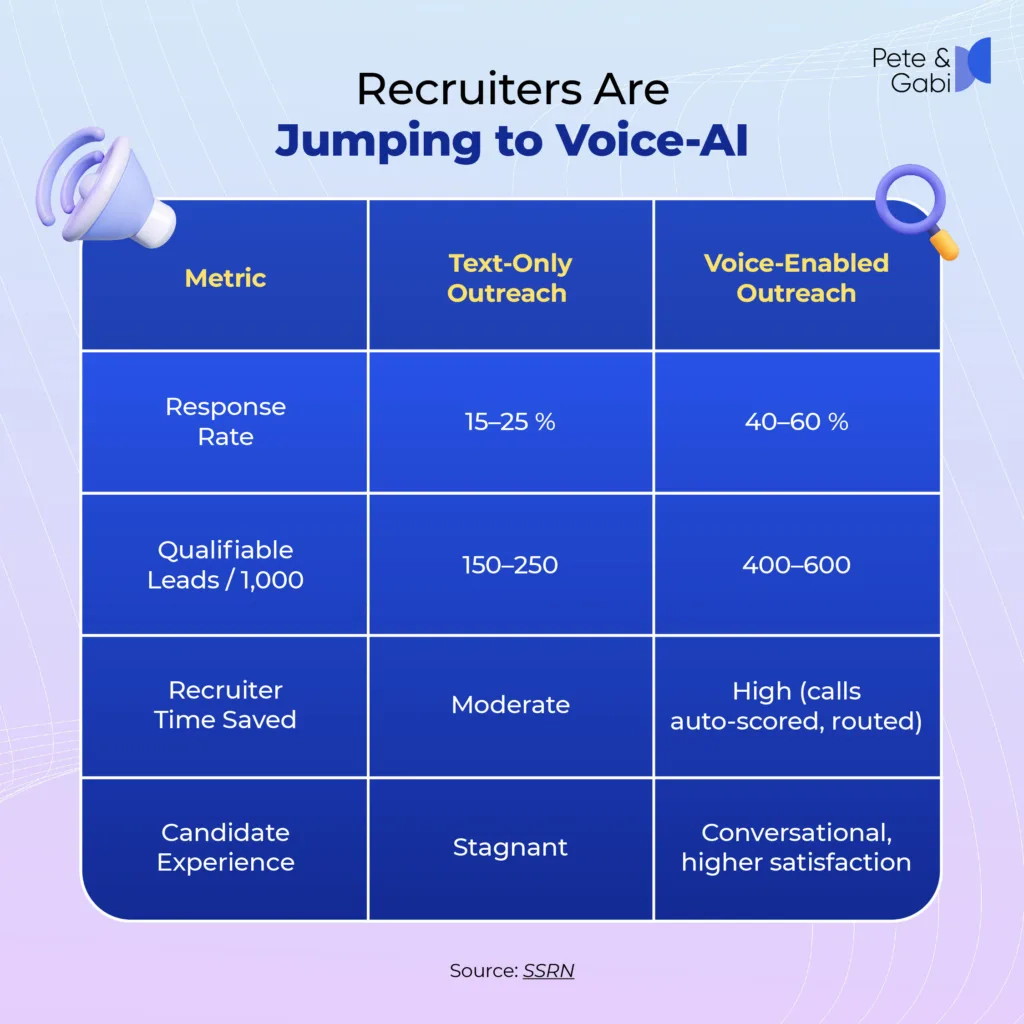
When Voice Backfires and How to Guard Against It
Voice isn’t magic, if poorly deployed, it ruins your employer brand. Here are the common pitfalls:
Over-Automation without Fallback
If the system can’t handle an edge reply, or defaults to awkward scripts or dead ends. Always allow real hand-off.
Poorly Phrased Prompts
Stilted, overly formal language makes voice sound robotic. Use natural, human phrasing.
Accent/Transcription Bias
Speech-to-text accuracy varies across accents, dialects or speech conditions. In one study, recognition errors spiked to 22% for certain accents. (Source: Truffle)
No Transparency
Candidates resent being surprised by AI. Let them know it’s automated, and route to human when needed. This is also potentially required by regulations in some areas.
Unbalanced Metrics Focus
Don’t reward sheer volume of voice calls. Reward outcome: engaged candidates, offers accepted, quality hires.
The academic community also warns bias in AI systems can become systematized if unchecked. Always audit your models for fairness.
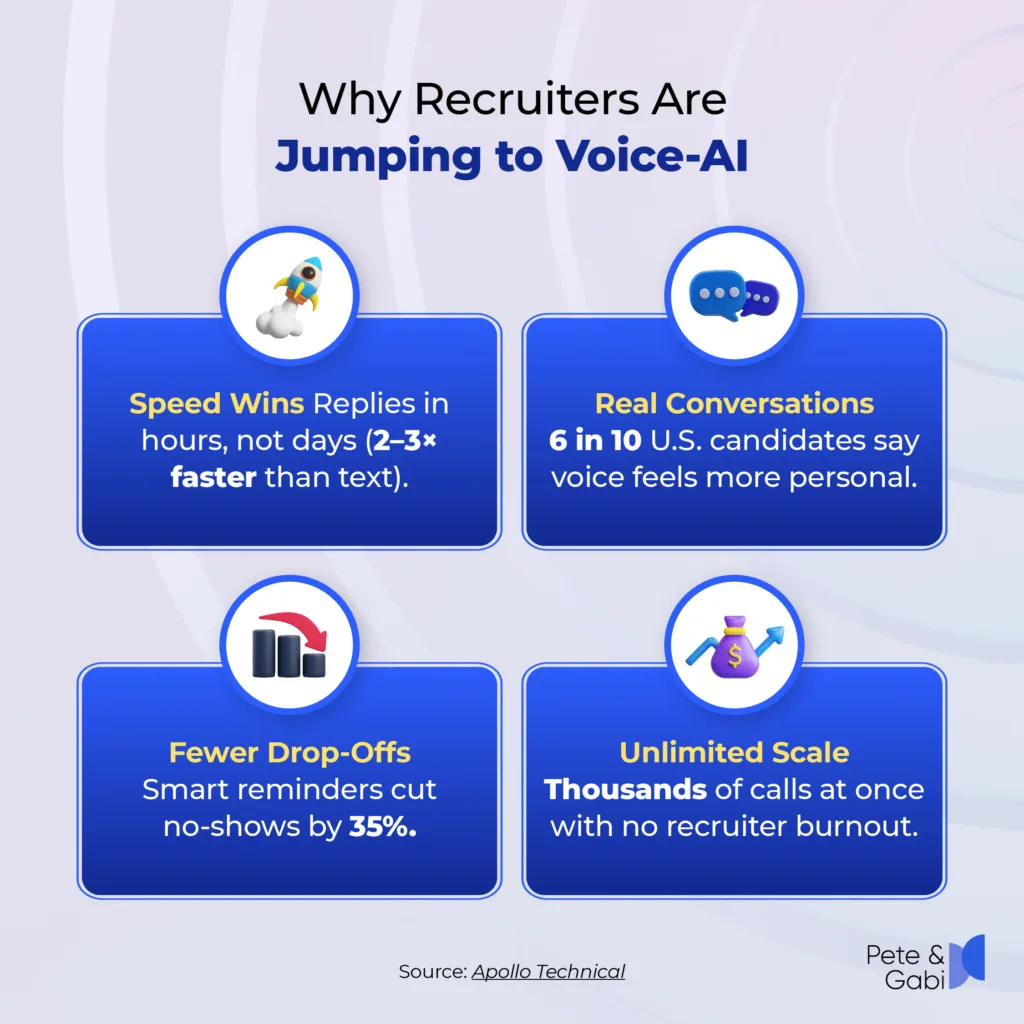
3 Steps to Deploy Your AI Candidate Engagement Software Confidently
1. Pilot voice on a narrow use case
Start with a single role or region. Use voice-based outreach for earlier-stage leads only. Validate scripts, MQL to SQL conversion, handoff thresholds.
2. Build script A/B experiments
Test multiple voice scripts, branching paths, content tones. In voice systems, one sentence shift can double drop-off rate.
3. Monitor equity & feedback
Track performance by demographic groups (accent region, gender, commute zones). Solicit candidate feedback (“Did you prefer the voice call, and did you realize it was AI?”).
Embed audits into your AI candidate engagement platform strategy so bias doesn’t creep in.
Use Cases That Nail It
High-Volume AI, Powered Hiring Processes (Retail, Drive-In Roles)
These roles require scale. Voice-based outreach helps convert warm leads fast, no mass SMS drip fatigue.
Re-Engaging Passive Candidates
A quick “Hey, this is [Name] from [Company], about X role…” in the candidate’s own tone can break through silence better than an email chain.
Post-Application Follow-Up
After a candidate applies, a voice call can confirm interest, nudge for missing info, and reduce drop-off before the screening stage.
Return-to-Work or Seasonal Campaigns
Use voice to re-activate past applicants. “We saw your profile; you might fit this upcoming opening.”
In all these, the core engine is your voice recruitment software, layered on top of your existing systems—not replacing them wholesale.
Pull It All Together: Your Voice Playbook
- Choose an AI candidate engagement platform that supports text to voice AI recruitment (not just SMS + voice as separate silos).
- Stitch voice logs, transcripts, and sentiment scores into your ATS/CRM.
- Let voice do the heavy lifting (screening, re-asks, drop-off detection). Human recruiters jump in with context.
- Run continuous experiments, script versions, branch logic, delivery timing.
- Ensure transparency, audit for bias, adopt candidate feedback loops.
If you do this right, you stop losing top talent to faster, more conversational competitors. You shift recruiting from “send and hope” to “speak and convert.”
At this moment, companies who embrace AI candidate engagement that moves beyond mere texting will be first to capture talent before competitors even respond.
FAQs
What is an AI candidate engagement platform?
It’s a system that automates outreach, screening, and follow-up, moving from text-only to voice recruitment software for faster, more human engagement.
Why move from text to voice in hiring?
Text gets ignored. Text to voice hiring recruitment automation tools double response rates and cut candidate drop-off by making conversations feel real.
How does voice recruitment software help recruiters?
It scales outreach, qualifies candidates instantly, and syncs transcripts into your ATS, freeing recruiters to focus on high-value conversations.
Is AI recruiting engagement replacing humans?
No. It handles volume and routine tasks. Recruiters still drive relationships, but with stronger pipelines from voice-based candidate outreach.
What results can companies expect?
US firms report 2–3× higher reply to rates, faster screening, and improved candidate experience when shifting to voice-powered AI recruiting engagement.



